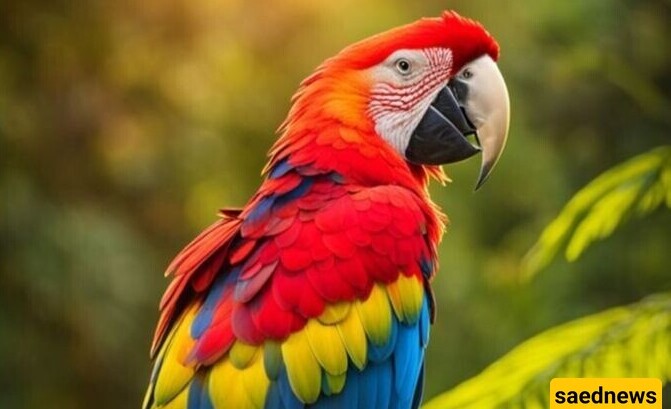The term "Synocarditis" refers to a condition in which a bird (such as a canary, goldfinch, finch, budgerigar, nightingale, cockatiel, mynah, pigeon, parrot, African grey, and other ornamental birds) becomes emaciated, the breast muscles waste away, and the breastbone appears prominently protruded in the middle of the chest.

According to the Pet Care Service of Saed News Agency, Synocarditis in birds, a common condition among ornamental species such as canaries, parrots, cockatiels, budgerigars, and pigeons, refers to a state in which the bird becomes severely emaciated and the breast muscles waste away, causing the keel bone (breastbone) to protrude sharply. This condition is not a disease in itself but rather a symptom of underlying issues such as infections, parasites, malnutrition, or chronic illnesses. In this article, based on credible scientific sources, we examine the symptoms, causes, and effective treatments of this condition to help bird breeders recognize and treat it in time.

Early detection is crucial to prevent the bird's death. Common symptoms include:
Protruding keel bone: Due to muscle wasting, the breastbone appears like a sharp blade.
Severe weight loss and emaciation: The bird gradually loses weight and becomes weak.
Lethargy and decreased activity: The bird moves less, appears puffed up, and shows no interest in flying or playing.
Changes in droppings: White, yellow, or bloody diarrhea and sometimes mucus-filled feces may indicate digestive issues.
Loss of appetite: The bird may refuse food or only eat specific seeds.
Changes in beak or feather color: In some cases, the beak becomes paler and feathers appear dull.
Breathing difficulties: Respiratory infections may cause wheezing or abnormal breathing.
Synocarditis results from underlying diseases or improper care. Major causes include:
Bacterial and parasitic infections: Bacteria like Salmonella or parasites like Coccidia cause intestinal inflammation, diarrhea, and poor nutrient absorption.
Malnutrition: Poor diet and deficiencies in calcium, vitamin D, or protein can lead to muscle wasting.
Stress: Overcrowded cages, sudden environmental changes, or predator presence reduce appetite and cause physical decline.
Chronic diseases: Respiratory infections, liver disorders, or illnesses like Newcastle disease may predispose birds to this condition.
Poor cage hygiene: Feces in food or water containers promote the spread of bacteria and parasites.
To accurately diagnose, the bird should be examined by an avian veterinarian. Diagnostic methods include:
Physical examination: Checking the bird’s weight and keel bone condition.
Fecal test: To identify parasites or harmful bacteria.
Blood test: To detect nutritional deficiencies or infections.
Imaging: In severe cases, X-rays may reveal bone or organ changes.
Treatment requires addressing the underlying cause. Effective methods include:
Avoid heavy foods like boiled egg and watery vegetables (e.g., lettuce) until recovery.
Use nutrient-rich foods such as boiled potatoes, wheat sprouts, almond and pistachio powder.
Add calcium and vitamin D supplements to strengthen bones.
Add 5–10 drops of natural apple cider vinegar to 100 cc of drinking water for 5 days to balance gut flora.
Provide bird-specific probiotics once a week.
Antibiotics like Tylosin (0.2 g per liter of water) or Amoxicillin for bacterial infections (under veterinary supervision).
Antiparasitic medications for treating coccidiosis or internal worms.

Raise ambient temperature to 25–30°C to maintain body heat.
Use an infrared lamp (3 times a day for 30 minutes each) to keep the bird warm.
Cover the cage surroundings to reduce stress.
Cage Hygiene:
Clean food and water dishes daily to prevent bacterial contamination.
Use grit or cuttlebone in the cage to provide necessary minerals for digestion.
Prevention is always better than cure. The following actions can help avoid synocarditis:
Balanced diet: Provide fresh seeds, suitable fruits and vegetables, and vitamin supplements.
Regular hygiene: Clean the cage and change food and water frequently.
Stress reduction: Avoid sudden environmental changes and overcrowding.
Routine checkups: Weigh the bird weekly and monitor for early signs of illness.
Vaccination and deworming: Follow a regular schedule under veterinary supervision.
Synocarditis in birds is a sign of more serious underlying issues that require immediate attention. With early symptom detection, improved diet, better care conditions, and proper treatment under a veterinarian’s supervision, the progression of this condition can be stopped and the bird’s health restored. Using reliable sources and consulting with experts in ornamental bird care is the key to effectively managing this problem.

